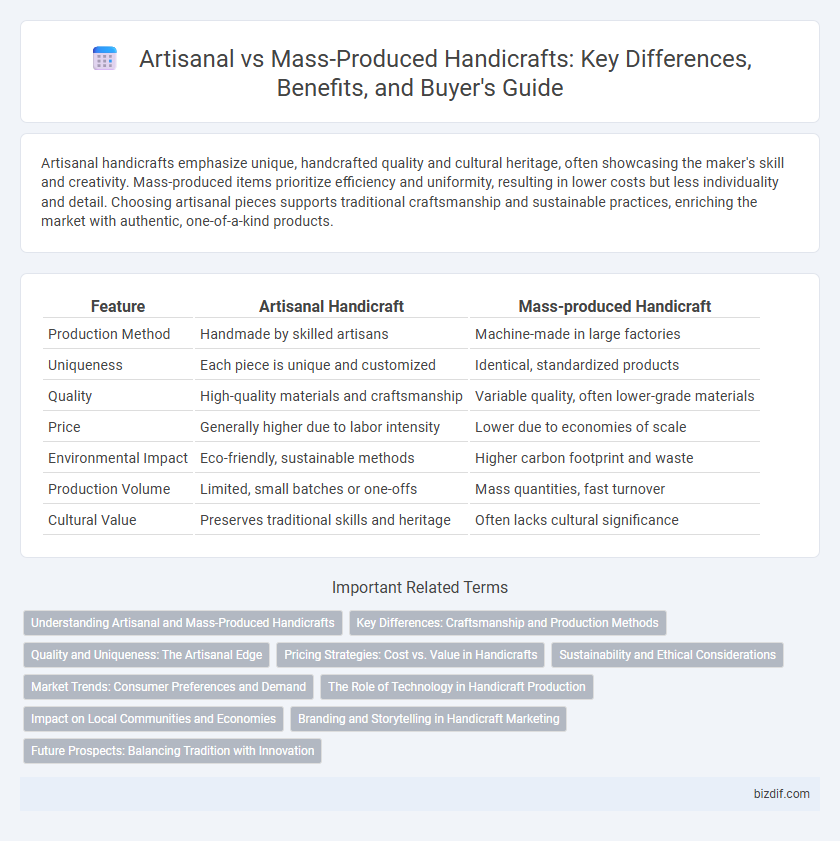Artisanal handicrafts emphasize unique, handcrafted quality and cultural heritage, often showcasing the maker's skill and creativity. Mass-produced items prioritize efficiency and uniformity, resulting in lower costs but less individuality and detail. Choosing artisanal pieces supports traditional craftsmanship and sustainable practices, enriching the market with authentic, one-of-a-kind products.
Table of Comparison
| Feature | Artisanal Handicraft | Mass-produced Handicraft |
|---|---|---|
| Production Method | Handmade by skilled artisans | Machine-made in large factories |
| Uniqueness | Each piece is unique and customized | Identical, standardized products |
| Quality | High-quality materials and craftsmanship | Variable quality, often lower-grade materials |
| Price | Generally higher due to labor intensity | Lower due to economies of scale |
| Environmental Impact | Eco-friendly, sustainable methods | Higher carbon footprint and waste |
| Production Volume | Limited, small batches or one-offs | Mass quantities, fast turnover |
| Cultural Value | Preserves traditional skills and heritage | Often lacks cultural significance |
Understanding Artisanal and Mass-Produced Handicrafts
Artisanal handicrafts showcase unique, handcrafted qualities created by skilled artisans using traditional techniques, resulting in distinctive cultural expressions and higher craftsmanship value. Mass-produced handicrafts, manufactured in large quantities using machines, prioritize uniformity and cost-efficiency but often lack individuality and the intricate details found in artisanal pieces. Understanding these differences highlights the cultural significance, quality, and sustainability embedded in artisanal handicrafts versus the commercial efficiency of mass-produced products.
Key Differences: Craftsmanship and Production Methods
Artisanal products emphasize unique craftsmanship, often involving hand skills and traditional techniques that result in limited, high-quality items. Mass-produced goods rely on automated processes and machinery, enabling large-scale manufacturing with consistent but less personalized output. The distinct production methods highlight the value of artisanal creativity versus the efficiency and uniformity of mass production.
Quality and Uniqueness: The Artisanal Edge
Artisanal handicrafts showcase superior quality through meticulous craftsmanship and attention to detail, distinguishing them from mass-produced items that prioritize quantity over finesse. Each artisanal piece is unique, embodying the maker's cultural heritage and creativity, which mass-produced products often lack due to standardized manufacturing processes. The artisanal edge lies in the authenticity and individuality embedded in handcrafted items, offering consumers distinct value beyond mere functionality.
Pricing Strategies: Cost vs. Value in Handicrafts
Artisanal handicrafts often command premium pricing due to the unique craftsmanship, time investment, and cultural value embedded in each piece, reflecting a cost-plus or value-based pricing strategy. Mass-produced items typically follow cost-based pricing focused on economies of scale, resulting in lower per-unit costs but reduced uniqueness and perceived value. Effective market positioning for artisanal products leverages storytelling and authenticity to justify higher prices that align with consumer willingness to pay for exclusivity and artisanal quality.
Sustainability and Ethical Considerations
Artisanal handicrafts prioritize sustainable materials and traditional techniques that minimize environmental impact compared to mass-produced goods reliant on synthetic inputs and large-scale manufacturing emissions. Ethical considerations in artisanal production emphasize fair wages, local craftsmanship preservation, and cultural heritage, contrasting with mass production's frequent reliance on exploitative labor practices and questionable sourcing. Supporting artisanal products nurtures circular economies, reduces carbon footprints, and champions social responsibility within global supply chains.
Market Trends: Consumer Preferences and Demand
Consumer preferences are increasingly favoring artisanal handicrafts due to their unique designs, superior craftsmanship, and cultural authenticity, driving a rising demand in niche markets. Mass-produced items dominate broader markets through affordability and consistency, but growing awareness of sustainability and ethical production is shifting consumer demand towards handmade goods. Market trends indicate a significant premium on personalized, eco-friendly artisanal products with provenance, reflecting evolving buyer values.
The Role of Technology in Handicraft Production
Technology in handicraft production enhances precision and efficiency without compromising the unique qualities of artisanal products. While mass-produced items benefit from automation and standardized processes, artisanal crafts integrate digital tools and machinery to preserve craftsmanship and innovate designs. The fusion of traditional skills with modern technology supports scalability and customization, elevating the value and appeal of handcrafted goods.
Impact on Local Communities and Economies
Artisanal handicrafts preserve cultural heritage and generate sustainable income by supporting local artisans, which strengthens community identity and economic resilience. In contrast, mass-produced goods often rely on factories and foreign supply chains, reducing opportunities for local employment and diminishing traditional skills. Investing in artisanal products promotes fair trade, ethical production, and long-term socioeconomic benefits for local economies.
Branding and Storytelling in Handicraft Marketing
Artisanal handicrafts emphasize unique branding and authentic storytelling that highlight the maker's heritage, techniques, and cultural significance, creating emotional connections with consumers. Mass-produced items often lack personalized narratives, relying instead on uniform branding and price competitiveness. Effective handicraft marketing leverages the artisanal story to differentiate products, build trust, and justify premium pricing in a crowded marketplace.
Future Prospects: Balancing Tradition with Innovation
Artisanal handicrafts emphasize unique, handcrafted techniques that preserve cultural heritage and support sustainable, local economies. Mass-produced items benefit from automation, enabling scalability and affordability but often lack the personalized quality intrinsic to artisanal products. Future prospects lie in integrating innovative technologies like 3D printing and eco-friendly materials with traditional craftsmanship to create hybrid models that appeal to both niche and global markets.
Artisanal vs Mass-produced Infographic

 bizdif.com
bizdif.com